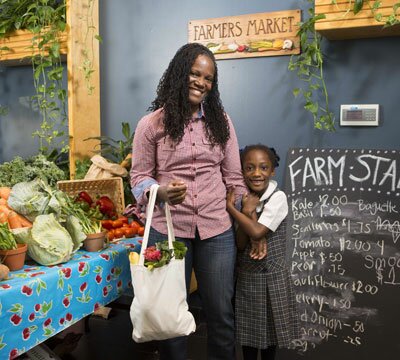The Dining Room is a learning environment where students and faculty eat family styles meals. With the intent of building a strong culture of community, each child has a responsibility to the table from setting to serving to composting. All meals are cooked from scratch, on site in accordance with our ingredients standards and food values while a central salad bar helps increase exposure to and consumption of fruits and vegetables.
Family Style Dining

Students are involved in all aspects of the meal including table preparation.
With a Family Style Dining model, students take a great deal of pride in their meals. Their pride is based on the privilege of eating nutritious food and being involved in serving and eating together as a community. We believe life is given more meaning and beauty with the daily ritual of the table; therefore, we encourage family style dining around a round table. Students and staff dine together and are involved in all aspects of the meal including, table preparations, serving, communal eating, clean-up and composting.
Food Values &
Ingredient Standards

Family style dining creates community around food and allows for students to continue strengthening these healthy relationships.
Committing to a “made-from-scratch” lunch program is our hopes for all schools. Use the following food values and ingredient standards as a model…
Ingredient Standards
- To make delicious, nutritious, seasonal and sustainable meals from scratch (no processed foods)
- To not use trans-fats and high fructose corn syrup
- To reduce or eliminate the use of refined sugars
- To use whole grain flours in baking, pastas and bread products
- To offer a Salad Bar with a majority of fresh items including at least one protein utilizing local produce when possible
- To serve fresh fruits and vegetables every day
- To serve water and non-fat milk (not flavored milk) and 100% fruit juices only

Lunches allow students enough time to serve, eat, clean-up and socialize.
Food Values
- To serve family style lunches
- To track all recipes in a nutrition data-base
- To purchase and prioritize local, regional and seasonal foods
- To ensure safe food handling of all food
- To make all condiments from scratch
- To roast all sandwich meats to avoid processed deli-style meats
- To eliminate salt in the Dining Room
- To make tasty food that people want to eat
Dining Room Initiatives
The Dining Room is a learning environment where food literacy lessons continue to be addressed. Some initiatives to enhance this learning environment:
- The Market Basket — Helps students identify the raw ingredients in the day’s meal.
- Tastings — Bi-weekly tastings expose students to ingredients that show up on the menu throughout the month.
- Signage — Utilize the Dining Room to send messages about food, health and community.
- Teach — Use lunch time to teach about local, seasonal and cultural values around food.
- Enjoy Community — Eating family style at round tables provides time to serve, eat, clean-up and socialize together.






